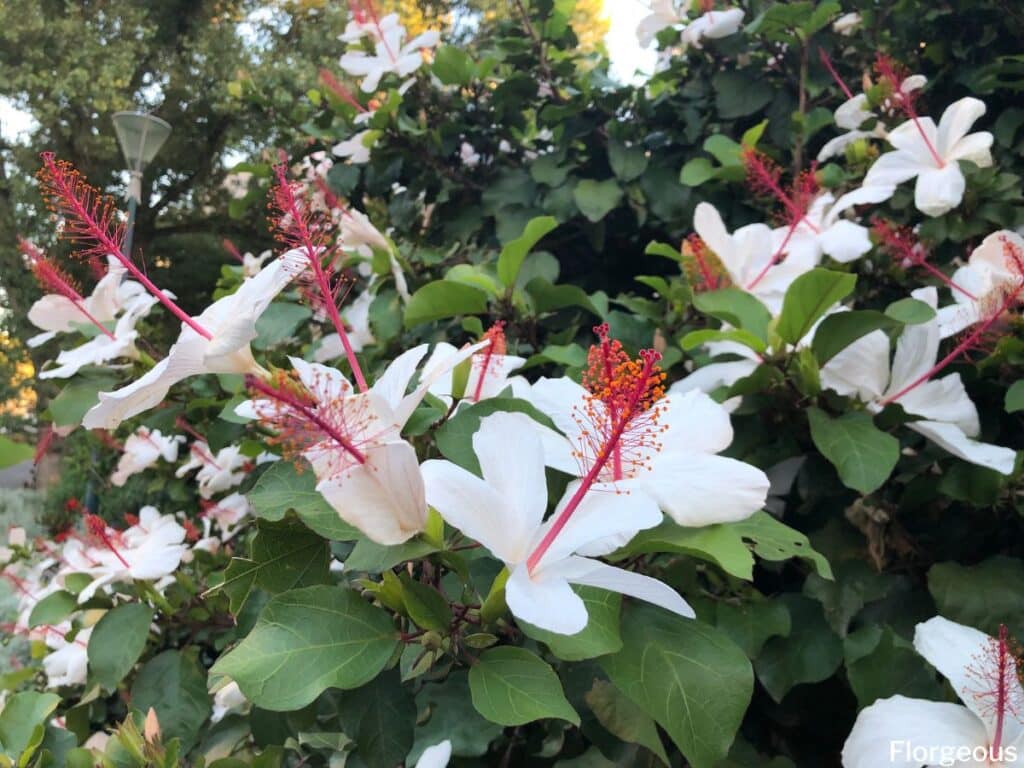The hibiscus plant (Hibiscus rosa-sinensis) can add a lot of color to your garden because it produces huge tapered flowers in colors like orange, yellow, red, and pink and there are also quite a few multicolored varieties. The sweet nectar of these flowers will also attract lots of hummingbirds and pollinating insects to your garden.
Gardeners love to pair hibiscus with flowering plants like bee balm or sweet alyssum and these shrubs flourish when you add ground covers like sweet potato vines underneath them. You can also create showy borders by pairing hibiscus with butterfly bush or fuchsias.
These companions can complement the beautiful flowering plants or they can be useful for maintaining year-round beauty and charm in your garden.
Let’s take a closer look at these hibiscus companion plants and interesting ways to use them in your garden landscapes.
What to Plant with Hibiscus Flowers
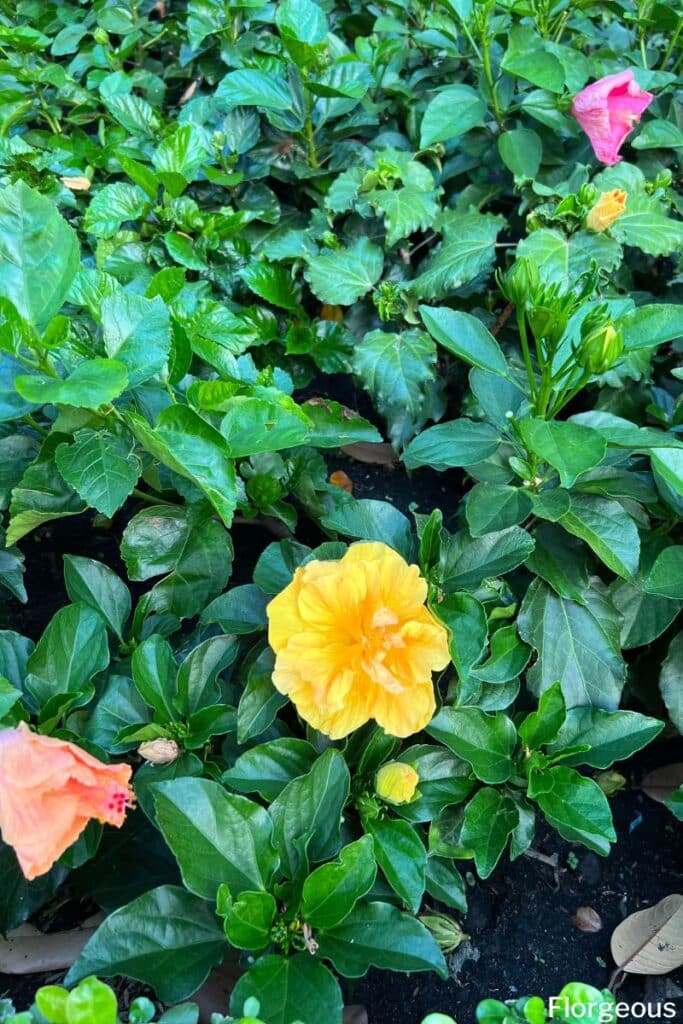
A lot of careful planning and research goes into finding suitable companion plants for hibiscus flowers. It is important to select plant species that won’t compete for resources like nutrients, water, or sunlight. You also need to be careful to select plants that have similar growing conditions or they won’t develop well in your hibiscus garden.
Hibiscus flowers are thirsty plants that need to be established in fertile, moist soil with lots of organic matter.
When it comes to growing hibiscus, these plants prefer slightly acidic soil that is loamy and the color of the flowers can be affected by the acidic level of the ground. These plants love lots of mulch around their base to keep the soil moist and cool.
The flowering plants love bright conditions. In cold climates, they will grow very well in full sun but in hot and dry regions, they should be positioned in a filtered shade area or their leaves and flowers can scorch. Be careful not to position it in full shade or these small trees might not produce any flowers.
Here is a quick look at some companion plants that will grow well next to different types of hibiscus plants.
Sweet Alyssum
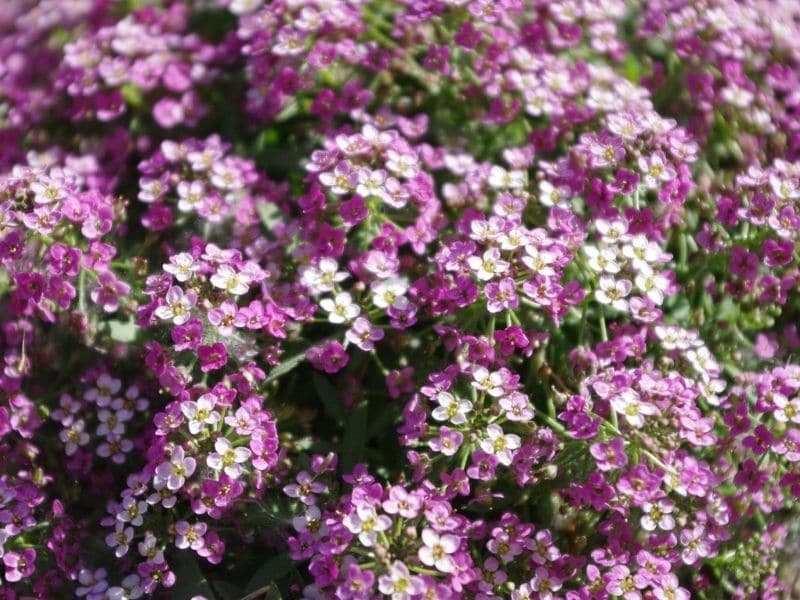
Sweet alyssum (Lobularia maritime), also referred to as sweet alison, are beautiful flowering companion plants to pair with hibiscus. These bushy plants produce delicate clusters of fragrant flowers in colors like white, deep purple, or pink flowers.
These small flowering shrubs will help protect your hibiscus flowers from common pests like aphids because they attract ladybugs that love to feed on these pests.
Sweet alyssum prefers well-drained soil and can tolerate dry soils but prefers regular yet moderate watering. They also grow well in full sun or partial shade.
Sweet alyssum is very useful as a ground cover, walkway edging, or border plant and can be grown in front of or around hardy hibiscus shrubs. Just be careful not to position these flowers directly under a large hibiscus plant because they won’t flower if they don’t get enough direct sunlight.
Sweet Potato Vines
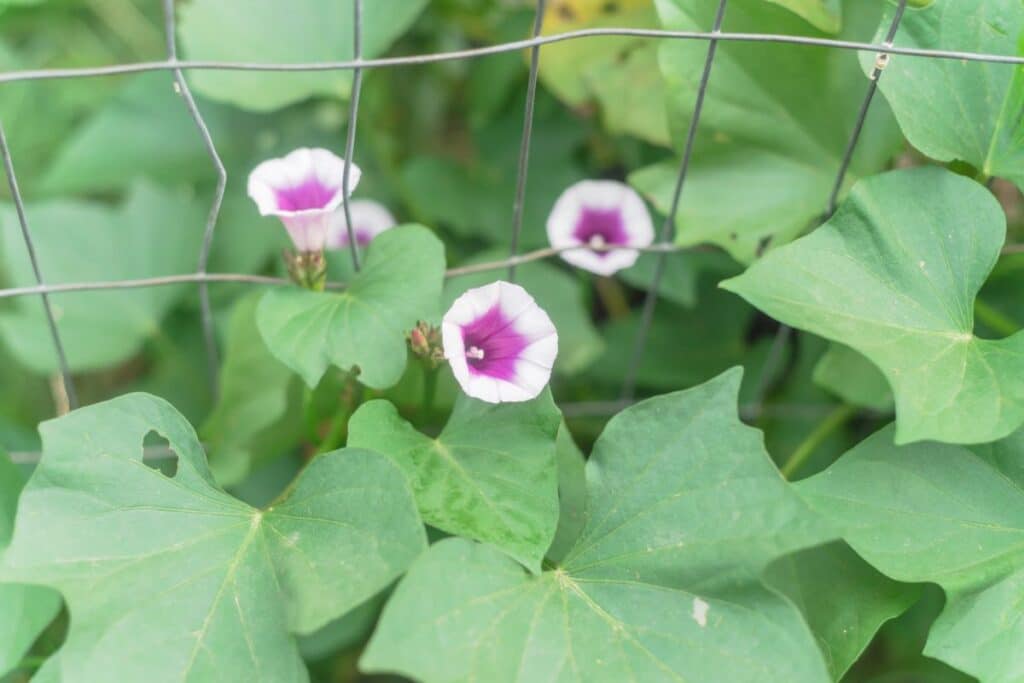
Ornamental sweet potato vine (Ipomoea batatas) is often used as a spiller plant in hanging baskets but this companion plant can be a very useful ground cover to keep the soil around your hibiscus plants cool and moist. The vibrant lime-green vine leaves will also lighten up dark areas around the base of your shrubs and will complement the large blooms very well.
Sweet potato vines are pretty easy to grow. They will flourish in any soil type that is rich in organic matter as long as the soil drains well. They can grow in warmer climates and prefer the humid conditions around the base of hibiscus trees.
These vines can adapt to various lighting conditions and can be planted in full sun to shade. The leaves do however look their brightest if they receive a minimum of 6 hours of full sun per day.
The sweet potato vine will look great if you mass plant it as a garden filler around the base of a showy hibiscus shrub or if you use it as a contrasting border in front of hibiscus hedges.
Fuchsias
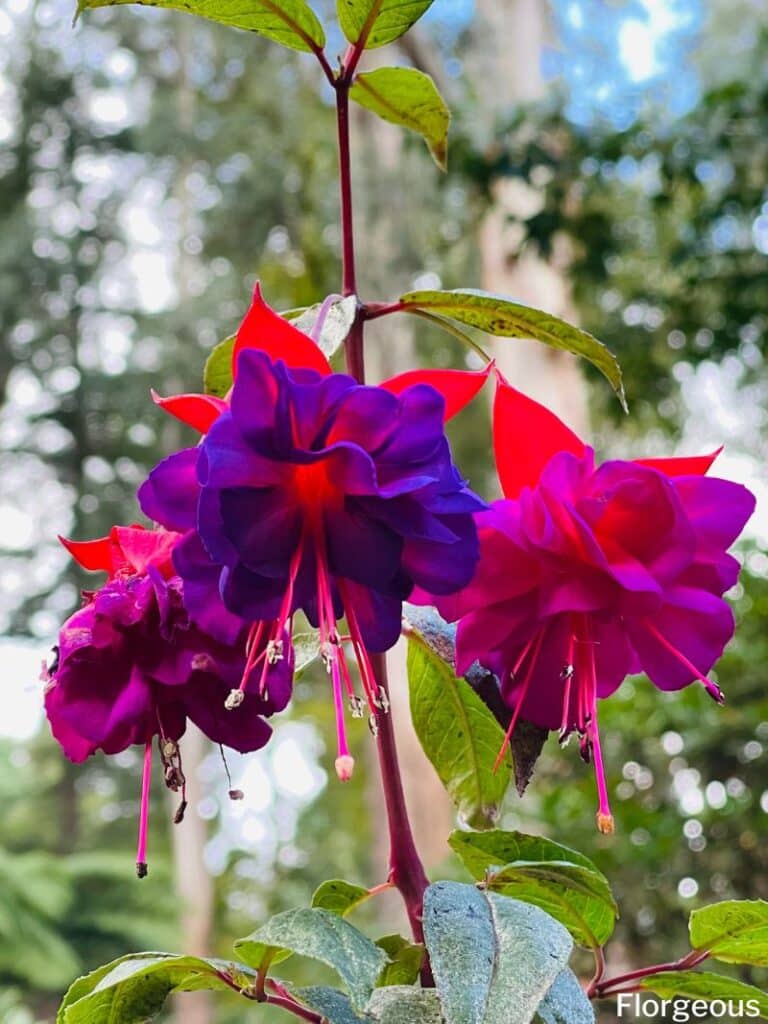
Fuchsias (Fuchsia magellanica) is also referred to as hummingbird fuchsias because hummingbirds absolutely love the sweet nectar these gorgeous flowers produce. Fuchsia purple flowers are great companion plants to grow next to smaller hibiscus varieties because they can help you create showy mixed hedges that attract lots of life and vibrancy to your garden.
As with hardy hibiscus, these shrubs grow well in full sun or partial shade and they love fertile, moist soil that drains well. They will also grow well in a garden bed, container, or hanging basket.
There are lots of different ways to use these shrubs or small trees in a hibiscus garden. You can use the ornamental plants as filler plants to conceal the bare base of a tall hibiscus plant or grow them in tandem with hibiscus shrubs of a similar height like rose mallow hibiscus to create striking borders.
Bee Balm
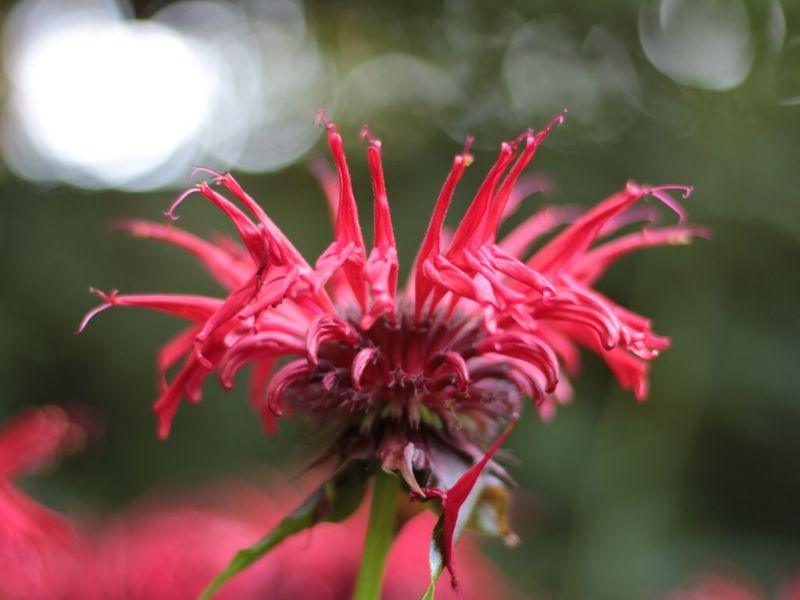
Bee balm (Monarda), also known as bergamot, is a very useful ground cover to pair with tropical hibiscus because the short flowers are easy to care for and will add lots of color to your garden bed. The strong fragrance of these plants is also useful for repelling some of the pests that might attack your hibiscus flowers.
This hibiscus companion plant prefers full sun and, even though it might not flower as much, it will also survive in partial shade. The flowers prefer moist but well-draining soil and prefer soil with plenty of organic matter.
The purple flowers will form a striking contrast with the dark green leaves of the hibiscus plant and they will quickly spread to cover your entire garden bed floor.
Butterfly Bush
Butterfly bush (Buddleja) is an ideal companion plant to pair with hibiscus if you want to add lots of texture to your garden. These perennial plants produce interesting flowers on tall spikes in colors like pale pink, lavender, lilac, orange, or white flowers.
This low-maintenance plant can be grown in full sun, shade, or semi-shade and will flourish if you grow it in well-draining soil that is rich in organic matter. These flowers will grow well in a garden bed but can also be planted in containers.
You can use dwarfed varieties of butterfly bush as a garden filler in front of summerific hibiscus in an area where they will receive lots of sunlight. Larger butterfly bush varieties can also be combined with hibiscus shrubs to create showy borders. Just be careful not to grow them too close together so they won’t start competing for sunlight.
What NOT to Plant with Hibiscus
Hibiscus shrubs can grow quite vigorously and these small trees can become quite tall. Tall varieties of these plants can block out the sun for other plants in your garden. It is best not to grow sun-dependent plants like roses, coneflowers, or sage directly underneath your hibiscus because they won’t flower or might develop powdery mildew.
Hibiscus plants also require frequent watering, especially during their flowering season. Plants that are prone to root rot such as yarrow, lavender, and sedums won’t grow well in the moist soil that hibiscus flowers love so much.
Landscaping Ideas for Hibiscus and Companions
Now that you know a bit more about great companion plant varieties to pair with hibiscus, it is time to explore some of the best ways to use them in your garden. Here is a quick look at some creative ideas that can help you create showy garden designs.
Mixed Containers
Hibiscus plants can grow well in containers and gardeners love to trim them into topiaries so they can produce interesting floral spheres when they bloom.
To make your containers look even more attractive, you can grow a filler plant underneath the hibiscus topiary. Flowers like bee balm, or sweet alyssum should look very appealing when both of these plants are in full bloom.
You can also consider adding a trailing plant like sweet potato vine to your mixed container so these vibrant leaves can spill out over the edge of your container.
Create Mixed Borders
Short hibiscus shrubs like summerific hibiscus can be paired with other flowering shrubs like butterfly bush or fuchsias to create striking borders with a variety of blooms. These floral borders or hedges can be very useful for covering up unsightly areas in your garden, and dividing garden spaces, or can be useful as privacy screens.
You can also edge these mixed borders with a lower ornamental plant like sweet alyssum to conceal the base of your shrubs and add more contrast and texture to your garden.
Play with Colors
There are over 200 different species of hibiscus and these include a wide range of vivid flower colors. To create visually stimulating gardens, you can play a bit with these colors and pair different varieties of hibiscus together or pair certain colors of hibiscus with flowers that can enhance their appeal.
For example, you might pair luna red hibiscus (hibiscus moschuetos) with a purple butterfly bush because the red and purple blooms will look rather striking next to one another.
Pink candy crush hibiscus can also look charming if it peeks out from behind the white flowers of sweet alyssum.
FAQs
What herbs go well with hibiscus?
Some herbs that go well with hibiscus include mint, lemon balm, lemongrass, and basil. These herbs complement the floral and tangy flavor of hibiscus tea and can be used to enhance its taste.
What planting mix for hibiscus?
A suitable planting mix for hibiscus should be well-draining and rich in organic matter. A mix of peat moss, compost, and perlite or sand works well. Avoid heavy soils that retain water, as hibiscus prefers soil that drains quickly.
Do hibiscus grow better in pots or ground?
Hibiscus can grow well both in pots and in the ground, but the choice depends on factors such as climate, space availability, and personal preference. In cooler climates or areas with limited space, growing hibiscus in pots allows for easier protection during cold weather and more control over soil conditions. However, in warmer climates with ample space, planting hibiscus directly in the ground can lead to larger and more vigorous growth.
Final Thoughts
Hibiscus plants are terrific ornamentals to include in your garden if you love large and showy flowers as well as the meaning behind hibiscus symbolism. These friendly plants can also be paired with ground covers like sweet potato vine, sweet alyssum, or bee balm to help the flowers flourish or you can pair them with other shrubs like butterfly bush or fuchsias to create interesting borders.
We hope that this guide helped you find some great companion plants to grow with hibiscus so you can create show-stopping plant combinations.
See more:

